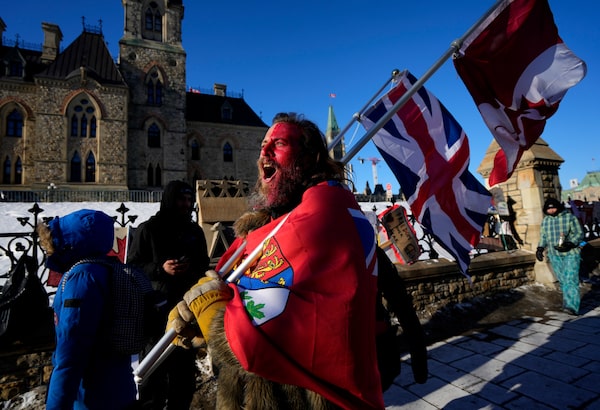
A protester yells 'freedom' at an anti-government protest in Ottawa, on Feb. 14.Justin Tang/The Canadian Press
Breakthrough? No, there was never going to be a breakthrough deal that would bring the truckers’ protests to some negotiated end.
Government documents filed in Federal Court momentarily raised the question of whether Justin Trudeau’s Liberal government invoked the Emergencies Act just as the whole crisis was about to go away – well, they actually underline the fact that there was no real negotiation to be had.
The lingering questions about the government’s use of the Emergencies Act have nothing to do with the potential for a breakthrough – which turned out to be an illusion.
The issue about the use of the act is whether it was absolutely necessary to use a tool that can only be justified when nothing else can be done – and why it came to that.
It is not whether authorities would have to eventually act to remove a convoy that planned to leave parked tractor-trailers on the streets of the capital to blockade its downtown indefinitely.
The minutes of cabinet and cabinet-committee meetings filed in court this week can remind us that that is what was happening in those cold February days.
They come to us courtesy of a case launched by a group called the Canadian Constitution Foundation, contesting the use of the Emergencies Act. They are heavily redacted, but even so it is rare for cabinet records to be released.
In them, the Prime Minister’s national security intelligence adviser, Jody Thomas, is reported to have spoken of a possible “breakthrough” in a cabinet meeting on Sunday, Feb. 13 – two weeks into the convoy protests and one day before the Emergencies Act was invoked.
According to the minutes, she gave an overview: She told ministers that there were still blockages at several border points, though police had finally cleared a blockade at Windsor’s Ambassador Bridge, that police were taking action at the border crossing in Coutts, Alta., that law enforcement had made important progress – and that there was “a potential for breakthrough” in Ottawa.
Convoy blockades cost Canadian economy billions in reduced GDP, documents show
On Thursday night, a government spokesman said Ms. Thomas was referring to the negotiations between convoy organizer Tamara Lich and Ottawa Mayor Jim Watson. And the failure of those talks, which was public at the time, was a pretty good signal about the prospects for negotiation.
Mr. Watson told the world on Feb. 13 that he had made a deal with Ms. Lich that would see the convoy move trucks away from residential streets the next day. It wasn’t to be an end, but a shift of trucks toward government buildings around Parliament. Ms. Lich was said to be seeking “buy-in” from the convoy, but by the end of the day, she had said there was no deal and it was all a media lie.
As his part of the bargain, Mr. Watson had offered to meet convoy organizers to hear their concerns. Before that, Ontario’s provincial government had offered to meet if protesters lifted the blockade of the Ambassador Bridge, to no avail.
It’s hard to figure what a bigger deal might have meant. Various convoy factions had demanded different things, such as the lifting of vaccine mandates for cross-border truckers, or all federal and provincial pandemic measures, and at one time launched a petition, later disavowed, for the overthrow of the Liberal government.
All that doesn’t mean the police necessarily had to rush immediately, if there was a point in waiting. But authorities were eventually going to have to act.
And that still doesn’t answer the questions about the use of the Emergencies Act.
That, like illegal blockades, is a matter of the rule of law. The Emergencies Act can only be used this way when no other law can deal with the crisis.
It was used to freeze bank accounts, and even if the goal was to scare truckers into leaving before a confrontation, it was an unprecedented use of big-government pressure. Would nothing else work? In the end, many of the protesters were cleared out with traditional police tactics.
But when Mr. Trudeau’s government was asked why it was necessary to invoke the act, one of its initial answers was a misleading claim that police had asked for it.
Mr. Trudeau’s government has yet to make the case – explicitly, and openly, and convincingly – that it met the high standard for invoking the nation’s most extraordinary law.
But the questions it must answer are not about whether it should have waited for a breakthrough that was never going to come.
Editor’s note: An earlier version of this article included an incorrect date regarding the convoy.
Know what is happening in the halls of power with the day’s top political headlines and commentary as selected by Globe editors (subscribers only). Sign up today.
 Campbell Clark
Campbell Clark